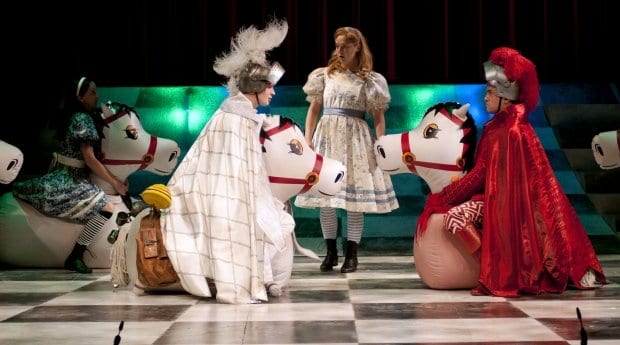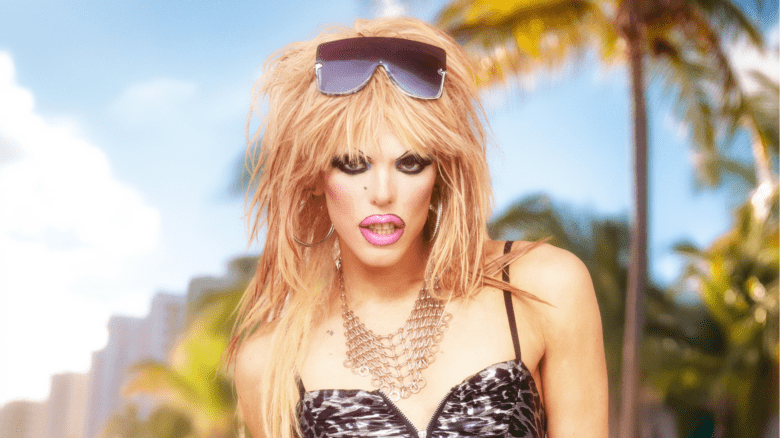We’re all dressing up for holiday parties but probably not in anything so spectacular as the costumes in Alice Through the Looking Glass.
Bretta Gerecke, an award-winning designer, created Alice’s costumes and sets in collaboration with Jillian Keiley, the play’s director. Due to its popularity, the play has an extended run at the National Arts Centre until Jan 3.
“We met in Newfoundland, and we spent four days kind of locked away just imagining what this world could be,” Gerecke says. “We really did it together, and the goal was to just imagine the most magical and fantastical place that kids in the audience from four to 94 could be swept away by and think of nothing but how much they would like to be part of the story.”
Alice was first introduced in Alice’s Adventures in Wonderland, an 1865 novel by Charles Lutwidge Dodgson, who is better known by his pseudonym, Lewis Carroll. In 1871, the sequel, Through the Looking-Glass, and What Alice Found There, was even more popular. James Reaney, a celebrated Canadian playwright who died in 2008, adapted the sequel for the stage. Using Reaney’s script, this production made its debut to excellent reviews at the Stratford Festival this past summer.
“It’s a highly imaginative, very fun [show] to design because you get to dive into that world of strange and wonderful characters that Carroll’s created,” Gerecke says. “I’m really struck by people today saying they want to feel something, that they want to go somewhere and have an experience that makes them feel something, and this is one of those shows. It just makes you do nothing but feel.”
The play features the actors of the NAC’s 2014/2015 ensemble, with Natasha Greenblatt as Alice, Lois Anderson as the White Queen, Alex McCooeye as the White Knight and Darrell Dennis as the Red Knight. But while Gerecke refuses to use the word “favourite,” she says designing the costumes for Tweedledum and Tweedledee was a singular experience.
“There’s no human form that looks like the Tweedles,” she says with a laugh. “The little, skinny stick legs and the giant centre body and this funny little head — I think those were the most fun to design.”
If you pictured designers off on their own, separate from the cast entirely, you’d be mistaken. Gerecke describes theatre as a group art form and enjoys working as a member of a creative team. While she was inspired by Sir John Tenniel’s classic drawings from the Carroll novels, watching the actors work was equally important in deciding how far she could go with the costumes, she says.
“They were a big experiment because the actors needed to try them in rehearsal and see if the shape was going to work, if they could roll around the way they need to roll around,” she says. “You’re creating a giant tummy and a big bum. You’re creating a shape that nobody is, to be honest, and that shape came from watching them in rehearsal but also from the old Tenniel drawings — the classic line.”
For Gerecke, the set and costumes aren’t separate from the actors or the story but an integrated part of the production that helps bring the story to life.
“I’m passionate about bringing an environment to life, creating a world that an audience can get lost in and feel like they’ve been transported,” she says. “I love that my job is to visually underpin the storytelling. It’s all about the story. I love that the challenge isn’t about making something beautiful — it’s about making something that works in a utilitarian way but also in a very passionate, connected way.”
Part of the magic of Alice Through the Looking Glass is letting yourself see the world through the eyes of a child, Gerecke says. Alice’s adventures involve amazement, laughter and larger-than-life characters but also raise issues that people of all ages can relate to, she says.
“I think audiences will like that it is full of surprise and heart and comedy, and it reminds you of what it’s like to still have the imagination of a child,” she says. “There are lots of big questions that Alice is asking, and they’re really important and beautiful. Who is she in the world? That’s really what she’s finding out. Every single character in this play is written to be seven and a half years old, so I think it’s a reminder of beauty.”
Alice Through the Looking Glass
Runs until Jan 3, 2015
National Arts Centre, 53 Elgin St
nac-cna.ca/englishtheatre/event/8444


 Why you can trust Xtra
Why you can trust Xtra


